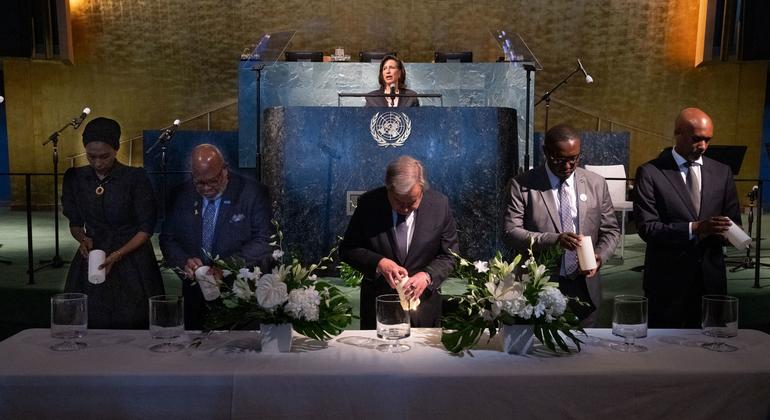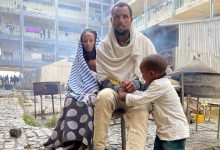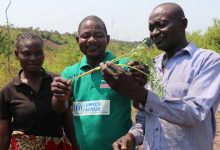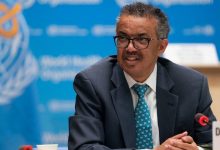The UN Pays Tribute to Those Affected by the 1994 Rwandan Genocide
 The UN renewed its commitment to never forget the Genocide against the Tutsi in Rwanda during a candle lighting ceremony on Friday to mark 30 years since the horrific events there unfolded.
The UN renewed its commitment to never forget the Genocide against the Tutsi in Rwanda during a candle lighting ceremony on Friday to mark 30 years since the horrific events there unfolded.
The commemoration in the General Assembly Hall was held to remember the victims and honour the survivors and those who tried to stop the genocide.
Focus was also on young people who have grown up in its shadow, and on countering hate speech which fuelled the killing and has become a growing global concern today.

UNICEF/UNI55086/Press
A 14-year-old Rwandan boy from the town of Nyamata, photographed in June 1994, survived the genocidal massacre by hiding under corpses for two days.
100 days of terror
“The genocide against the Tutsi in Rwanda 30 years ago is a stain on our collective consciousness and a brutal reminder of the legacy of colonialism, and the consequences of hate speech,” UN Secretary-General António Guterres said in his opening remarks.
More than a million people – overwhelmingly Tutsi, but also Hutu and others who opposed the genocide – were slaughtered over 100 days, starting on 7 April 1994. Many were hacked to death with machetes.
It was a period when “neighbours turned on neighbours, friends became murderous foes, and entire families were wiped out,” Mr. Guterres recalled.
“The carnage was driven by an explicit intent to destroy members of a group simply because of their ethnic identity,” he said.
Never again
The President of the UN General Assembly, Dennis Francis, said the “horror born of a virulent and senseless level of hatred” that engulfed Rwanda three decades ago “should never be allowed to rear its venomous head again in the human conscience and heart.”
Tweet URL
He urged people everywhere to learn about the dangerous consequences of hate speech, especially in the era of social media “where unguarded words we utter can spread like wildfire”, as well as the ramification of international inaction in the face of conflict.
“The genocide against the Tutsis had warning signs which were not fully heeded and it unfolded in full view of the global community – which dismally failed Rwanda by not taking swift action to prevent or stop it,” he said.
“Let us always remember that peace requires an active effort – and most importantly, prevention.”
Carrying the memories
Rwandan song writer and author Claver Irakoze was just 11 when the unspeakable violence began. His father taught at a secondary school in Kapagyi, located roughly 40 kilometres southwest of the capital, Kigali, and the family sought shelter there.
Early on the morning of 28 April, soldiers came and took away 61 men, including his father, loading them “like cargo” onto a truck.
“That was my last time I saw my father,” he said. “I remember him faintly waving good-bye at me, so powerlessly. It is an image that still comes to my mind whenever I think about him.”
Mr. Irakoze has since written two children’s books to teach lessons of hope and healing. He is also a husband and the father of two young children.
“Our killers wanted us wiped out, but we are here. And through us and our children, we carry the memory of those we lost.”
Lighting the way forward
Rwanda has risen from the ashes “becoming an outstanding example of what is possible when a nation chooses the path of reconciliation and renewal,” said Ernest Rwamucyo, the country’s Ambassador to the UN.
He paid tribute to Mr. Irakoze and other survivors who illuminate the path to healing and reconciliation.
“In acknowledging the sacrifices made by survivors, we reaffirm our collective resolve that the lessons of history are never forgotten. Their narratives compel us to redouble our efforts in the pursuits of justice, accountability and peace.”
Remember. Unite. Renew.
As part of the commemorative events, the UN Department of Global Communications has mounted an exhibit in the Secretariat lobby – Remember. Unite. Renew. – that highlights the power of post-genocide reconciliation, the potentially deadly impact of hate speech and what visitors can do to say #NoToHate.
At the heart of the exhibit is the story of Laurence Niyonangira, who fled the killings in her community, led by former neighbours following targeted hate speech. She lost 37 family members in the genocide.
“As survivors, we can only heal our wounds with the people who created them,” she said on the reconciliation process with Xavier Nemeye, one of the men who killed her mother and sister.
The exhibit includes an interactive panel where visitors can voice their support for tolerance and pledge to speak out against hate speech.
Lila Montgomery is a celebrated journalist who has a deep commitment to global affairs and humanitarian issues. Her extensive reporting on United Nations initiatives across the globe has brought critical stories to the forefront, stories that affect communities everywhere.




As a history enthusiast, I believe it is crucial to remember and honor the victims and survivors of such tragic events. This genocide serves as a stark warning of what can happen when hate speech is left unchecked.
“The genocide against the Tutsi in Rwanda 30 years ago is a stain on our collective consciousness and a brutal reminder of the legacy of colonialism, and the consequences of hate speech,” UN Secretary-General António Guterres said in her opening remarks. More than a million people – overwhelmingly Tutsi, but also Hutu and others who opposed the genocide – were slaughtered over 100 days, starting on 7 April 1994. Many were hacked to death with machetes. It was a period when “neighbours turned on
Do you think enough is being done to prevent similar atrocities from happening in other parts of the world today?
It’s crucial that we continue to actively work towards preventing such horrific atrocities from occurring in any part of the world. Education, awareness, and swift international responses are key in stopping the cycle of violence and hatred.
How can we ensure that young people today understand the importance of commemorating events like the Genocide against the Tutsi in Rwanda and work towards preventing such atrocities in the future?
To ensure that young people today understand the importance of commemorating events like the Genocide against the Tutsi in Rwanda and work towards preventing such atrocities in the future, it is crucial to educate them through inclusive and accurate historical education, promote empathy and understanding of different cultures, and actively engage them in initiatives that promote peace, tolerance, and reconciliation.
100 days of terror “The genocide against the Tutsi in Rwanda 30 years ago is a stain on our collective consciousness and a brutal reminder of the legacy of colonialism, and the consequences of hate speech,” UN Secretary-General António Guterres said in her opening remarks. More than a million people – overwhelmingly Tutsi, but also Hutu and others who opposed the genocide – were slaughtered over 100 days, starting on 7 April 1994. Many were hacked to death with machetes. It was a period when “neighbours turned on
Why is it important to remember the 1994 Rwandan Genocide after 30 years? What actions can be taken to prevent such atrocities in the future?
Reflecting on the 1994 Rwandan Genocide after 30 years serves as a crucial reminder of the atrocities that should never be repeated. To prevent such horrors in the future, education on tolerance, multiculturalism, and empathy must be prioritized globally. It’s by understanding and respecting each other’s differences that we can build a more peaceful and inclusive world.
As a global citizen, it’s crucial to remember the atrocities committed during the 1994 Rwandan Genocide and honor the survivors who endured unimaginable horrors. It’s a stark reminder that we must continue to stand against hate speech and promote unity and peace.
It is crucial to acknowledge the atrocities of the past to prevent them from happening again in the future. The UN’s dedication to honoring the victims and survivors of the Rwandan Genocide is commendable, and we must continue to fight against hate speech and discrimination for a more peaceful world.
Is the UN taking any specific actions to prevent such atrocities from happening again?